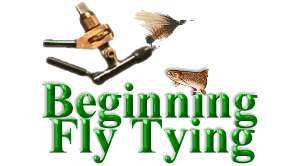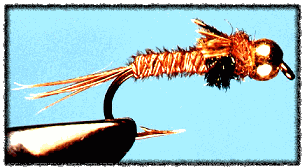If you had to pick the most popular nymphs
of all time, you'd be hard pressed to find two
nymphs more popular than the Pheasant Tail and
Hare's Ear. I would venture that more fish have
been caught on these two nymphs than any other
ten nymphs combined. The secret to their success is
probably in the fact that these nymphs do such a
good job of imitating a wide variety of aquatic
nymph forms.
The Hare's Ear is a good pattern to imitate
a caddis larva case or a mayfly nymph. Don't
stop there though, it also does a good job
imitating a stonefly nymph or damsel fly nymph.
I guess it's success is due to the fact it
doesn't look exactly like anything, but it
does look a lot like everything in the nymph
world. Add the fact you can use dyed hair and
synthetic fibers in the dubbing mix, and you
can produce a nymph that looks like almost
anything.
The Pheasant Tail nymph is almost as versatile
as the Hare's Ear. Substitute dubbing for the
peacock herl in the thorax area, or use
bleached or dyed pheasant tail feathers,
and you can make a nymph that looks like
anything you want to imitate.
That's right, I suggested substituting materials.
These are basic, standard patterns, but you
have the freedom to alter them to meet your
needs. That's why so many people take up fly
tying in the first place; they can create flies
that better fit their needs by changing a standard
pattern a little. You are in control here.
It's your fly, and you have the freedom to make
it any way you want to, as long as you aren't tying
for commercial purposes. (Commericial tyers must
consistantly produce the same fly the buyer ordered.)
So get creative if you want, you might be surprised
by the results.

|

































